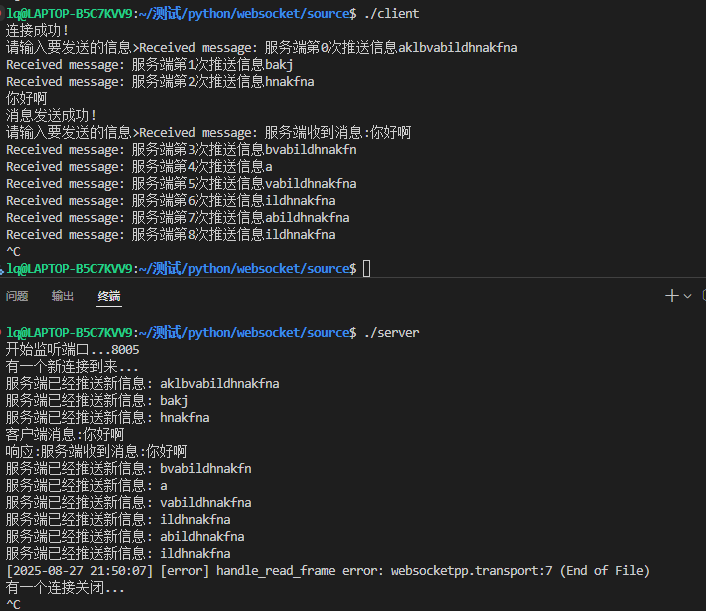目录
websocket协议
WebSocket是一种在单个TCP连接上进行全双工通信的应用协议,允许服务端和客户端实时双向数据传输。它通过HTTP/HTTPS的初始握手建立连接,之后转为独立的WebSocket协议通信,适用于需要低延迟和高频交互的场景(如在线游戏、实时聊天)。
websocket协议的出现就是为了解决http协议服务端无法主动向客户端推送信息的问题。
websocketpp库
websocket协议支持多种语言使用,而websocketpp就是C++语言使用的一套与websocket相关的一套API。
安装websocketpp
1.直接使用linux包管理器安装(Centos要使用yum)
bash
sudo apt-get install libwebsocketpp-dev2.使用源码安装
bash
git clone https://github.com/zaphoyd/websocketpp.git
cd websocketpp
mkdir build && cd build
cmake ..
make
sudo make install安装好之后检查是否安装成功,查看该目录是否存在,如果存在说明安装成功了;
指令:ls /usr/include/websocketpp
websocketpp的用法
这里我写了个简单的demo来测试websocketpp的使用。
websocketpp服务器
cpp
#pragma once
#include <iostream>
#include <websocketpp/connection.hpp>
#include <websocketpp/server.hpp>
#include <websocketpp/close.hpp>
#include <websocketpp/config/asio.hpp>
#include <websocketpp/common/functional.hpp>
#include <functional>
#include <sstream>
#include <unordered_set>
#include <vector>
#include <memory>
#include <atomic>
#include <thread>
#include <unistd.h>
typedef websocketpp::server<websocketpp::config::asio> websocket_server; // 服务器别名
typedef websocket_server::message_ptr message_ptr;
using msg_callback = std::function<void(websocketpp::connection_hdl, websocket_server::message_ptr)>;
class Server
{
public:
Server() : _count(0)
{
_server.init_asio(); // 初始化服务器
_server.set_reuse_addr(true); // 设置地址重用
_server.set_access_channels(websocketpp::log::alevel::none); // 关闭日志
// 设置回调函数
_server.set_open_handler(bind(&Server::on_open, this, std::placeholders::_1)); // 回调的时候会自动传递一个connection_hdl参数
_server.set_close_handler(bind(&Server::on_close, this, std::placeholders::_1));
_server.set_message_handler(bind(&Server::on_message, this, std::placeholders::_1, std::placeholders::_2)); // 两个参数(connection_hdl,message_ptr)
}
// 设置监听端口
void set_listen(int port)
{
_server.listen(port); // 0.0.0.0
std::cout << "开始监听端口..." << port << std::endl;
}
// 开始运行服务器
void run()
{
_server.start_accept();
_server.run();
}
void push_message()
{
std::thread push_thread([this]()
{
while (true)
{
std::stringstream ss;
ss << "服务端第" << _count++ << "次推送信息";
if(_connections.size()==0)
{
continue;
}
// 每过5s推送一次信息
for (auto &hdl : _connections)
{
std::string content = get_string();
std::string push_message = ss.str() + content; // 读取缓冲区数据
websocket_server::connection_ptr connection = _server.get_con_from_hdl(hdl); // 获取连接指针
// 开始推送信息
connection->send(push_message);
std::cout << "服务端已经推送新信息: " << content << std::endl;
sleep(5);
}
} });
push_thread.detach();
}
private:
// 用于测试服务端主动测试的字符串
std::string get_string()
{
std::string str = "acbakjvbaklbvabildhnakfna";
// 使用随机数,随机获取区间,截取
int start = rand() % str.size();
int end = start + rand() % (str.size() - start);
return str.substr(start, end);
}
// 注册连接回调函数
void on_open(websocketpp::connection_hdl hdl)
{
std::cout << "有一个新连接到来..." << std::endl; // 提示信息
_connections.insert(hdl);
}
// 注册关闭回调函数
void on_close(websocketpp::connection_hdl hdl)
{
std::cout << "有一个连接关闭..." << std::endl;
_connections.erase(hdl);
}
// 注册处理消息回调函数
void on_message(websocketpp::connection_hdl hdl, message_ptr msg)
{
std::string message = msg->get_payload(); // 读取消息
std::cout << "客户端消息:" << message << std::endl;
// 下面是响应处理逻辑
std::string echo_response = "服务端收到消息:";
echo_response += message;
// 将连接句柄转化为连接指针
websocket_server::connection_ptr connection = _server.get_con_from_hdl(hdl);
// 发送响应
connection->send(echo_response);
std::cout << "响应:" << echo_response << std::endl;
}
// 构建链接句柄哈希
struct connection_hdl_hash
{
std::size_t operator()(const websocketpp::connection_hdl &hdl) const
{
return reinterpret_cast<std::size_t>(hdl.lock().get());
}
};
struct connection_hdl_equal
{
bool operator()(const websocketpp::connection_hdl &a, const websocketpp::connection_hdl &b) const
{
return !a.owner_before(b) && !b.owner_before(a);
}
};
std::unordered_set<
websocketpp::connection_hdl,
connection_hdl_hash,
connection_hdl_equal>
_connections;
websocket_server _server;
std::atomic<size_t> _count;
// std::unordered_set<websocketpp::connection_hdl, connection_hdl_hash> _connections;
};
class ServerBuilder
{
public:
std::shared_ptr<Server> build()
{
return std::make_shared<Server>();
}
};websocketpp客户端
cpp
#include <iostream>
#include <websocketpp/connection.hpp>
#include <websocketpp/client.hpp>
#include <websocketpp/close.hpp>
#include <websocketpp/config/asio.hpp>
#include <websocketpp/common/functional.hpp>
#include <functional>
#include <unordered_set>
#include <vector>
using namespace std;
using websocket_client = websocketpp::client<websocketpp::config::asio>;
// 客户端对象
websocket_client client;
// 连接句柄
websocket_client::connection_ptr con_ptr;
void on_message(websocketpp::connection_hdl, websocket_client::message_ptr msg)
{
cout << "Received message: " << msg->get_payload() << endl;
}
void on_open(websocketpp::connection_hdl hdl)
{
if (hdl.lock() != nullptr) // lock方法是获取连接句柄的智能指针
{
std::cout << "连接成功!" << std::endl;
con_ptr = client.get_con_from_hdl(hdl);
std::thread echo_thread([]() {
if (con_ptr != nullptr)
{
while (true)
{
std::cout << "请输入要发送的信息>";
std::string message;
std::cin >> message;
con_ptr->send(message);
std::cout << "消息发送成功!" << std::endl;
}
}
});
echo_thread.detach();
}
else
std::cerr << "连接失败!" << std::endl;
}
// 连接关闭时调用的,只要调用了就是连接关闭了
void on_close(websocketpp::connection_hdl hdl)
{
if (hdl.lock() != nullptr)
{
std::cout << "连接关闭!" << std::endl;
}
}
int main()
{
client.init_asio(); // 初始化
client.set_access_channels(websocketpp::log::alevel::none); // 关闭日志
client.set_open_handler(&on_open);
client.set_message_handler(&on_message);
client.set_close_handler(&on_close);
websocketpp::lib::error_code ec;
auto con = client.get_connection("ws://0.0.0.0:8005", ec);
if (ec)
{
std::cout << "连接端口8005失败: " << ec.message() << std::endl;
return 1;
}
client.connect(con);
// 不再在 main 中创建输入线程,输入线程在 on_open 回调中启动
// 运行客户端
client.run();
return 0;
}makefile文件
cpp
all:server client
server:server.cc
g++ -o server server.cc -std=c++11 -lboost_system -lssl -lcrypto
client:client.cc
g++ -o $@ $^ -std=c++11 -lboost_system -lssl -lcrypto
.PHONY:clean
clean:
rm -rf server client结果
